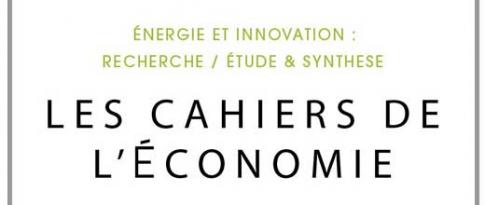23.10.2025
20 minutes de lecture
La collection “IFPEN Economic Papers” – anciennement « Les Cahiers de l’Économie », depuis 1990 – a pour objectif de présenter des travaux réalisés à IFP Energies nouvelles et IFP School qui traitent d’économie, de finance ou de gestion de la transition énergétique.
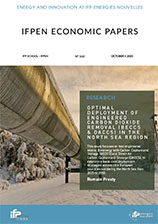 Optimal Deployment of Engineered Carbon Dioxide Removal (BECCS & DACS) in the Northsea Region
Optimal Deployment of Engineered Carbon Dioxide Removal (BECCS & DACS) in the Northsea Region
N° 163 – October 2025 [ RECHERCHE ]
Romain Presty
This study focuses on two engineered options: Bioenergy with Carbon Capture and Storage (BECCS) and Direct Air Carbon Capture and Storage (DACCS), to determine least-cost deployment strategies across nine European
countries bordering the North Sea from 2025 to 2050.![]() Lire la suite / Télécharger le numéro (PDF - 6.5 Mo)
Lire la suite / Télécharger le numéro (PDF - 6.5 Mo) ![]()
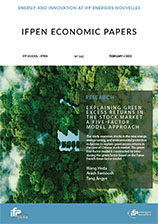 Explaining Green Excess Returns in the Stock Market: A Five-Factor Model Approach
Explaining Green Excess Returns in the Stock Market: A Five-Factor Model Approach
N° 162 – February 2025 [ RECHERCHE ]
Wang Heda, Arash Farnoosh and Tang Jingyea
The study examines stocks in the new energy, energy-saving, and environmental protection industries to explain green excess returns in the case of Chinese stock market. The green four-factor model is constructed by introducing the green factor based on the Fama-French three-factor model. Empirical results show that this model better explains the risk-return of green concept stocks compared to the three-factor model by verifying the existence of green excess returns, though its explanatory power still needs improvement. Therefore, the study uses stock turnover rate and the firm's return on investment as indicators of the sentiment factor and the efficiency factor, respectively, from the perspectives of green investment sentiment in behavioral finance and positive externalities in microeconomics. The green five-factor model is then constructed by introducing the green sentiment factor and green efficiency factor. Empirical results show that the green five-factor model better interprets the risk-return of green concept stocks compared to the three-factor model and the green four-factor model, with the green sentiment factor and green efficiency factor having a significant positive effect on the return of green concept stocks.![]() Lire la suite / Télécharger le numéro (PDF - 6.7 Mo)
Lire la suite / Télécharger le numéro (PDF - 6.7 Mo) ![]()
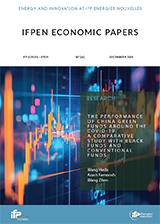 The Performance of China Green Funds around the COVID-19: A Comparative Study with Black Funds and Conventional Funds
The Performance of China Green Funds around the COVID-19: A Comparative Study with Black Funds and Conventional Funds
N° 161 – December 2024 [ RECHERCHE ]
Wang Heda, Arash Farnoosh and Wang Zhen
The analysis covers 102 green funds, 64 black funds, and 434 conventional funds in China, comparing their performance over 93 sample intervals from November 2015 to July 2023. The performance of green and black funds is significantly higher than that of conventional funds over the entire sample period, primarily due to the greater impact of COVID-19 on the industries in which conventional funds invest. Notably, green funds outperform black funds. When dividing the sample period at the onset of COVID-19, it is found that conventional funds generally outperform green and black funds before the pandemic, while green and black funds significantly outperform conventional funds during COVID-19. After COVID-19, as the state promotes economic recovery, conventional funds again outperform green and black funds. Overall, the performance of green funds gradually improves over time, with increased investment in large-cap and growth stocks.![]() Lire la suite / Télécharger le numéro (PDF - 4.1 Mo)
Lire la suite / Télécharger le numéro (PDF - 4.1 Mo) ![]()
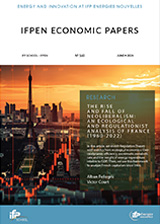 The rise and fall of Neoliberalism: an ecological and regulationist analysis of France (1960-2022)
The rise and fall of Neoliberalism: an ecological and regulationist analysis of France (1960-2022)
N° 160 – June 2024 [ RECHERCHE ]
Alban Pellegris and Victor Court
In this article, we enrich Regulation Theory with metrics from ecological economics: thermodynamic efficiency, exosomatic metabolic rate and the weight of energy expenditure relative to GDP. Then, we use this framework to analyze French capitalism since 1960.![]() Lire la suite / Télécharger le numéro (PDF - 3.4 Mo)
Lire la suite / Télécharger le numéro (PDF - 3.4 Mo) ![]()
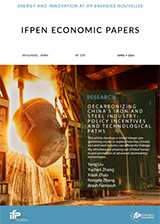 Decarbonizing China’s iron and steel industry: policy incentives and technological paths
Decarbonizing China’s iron and steel industry: policy incentives and technological paths
N° 159 – Avril 2024 [ RECHERCHE ]
Yang Liu, Yuchen Zhang, Xiaoli Zhao, Rongda Zhang and Arash Farnoosh
This article develops a mixed integer programming model to explore how the Chinese iron and steel industry can efficiently manage the simultaneous phasing out of blast furnaces and promotion of advanced steelmaking technologies.![]() Lire la suite / Télécharger le numéro (PDF - 4 Mo)
Lire la suite / Télécharger le numéro (PDF - 4 Mo) ![]()
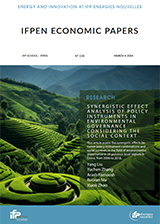 Synergistic effect analysis of policy instruments in environmental governance considering the social context
Synergistic effect analysis of policy instruments in environmental governance considering the social context
N° 158 – Mars 2024 [ RECHERCHE ]
Yang Liu, Yuchen Zhang, Arash Farnoosh, Ruoran Ma and Xiaoli Zhao
This article assess the synergistic effects between policy instrument combinations and social contexts in the field of environmental governance in 29 province-level regions in China, from 2006 to 2018. ![]() Lire la suite / Télécharger le numéro (PDF - 6 Mo)
Lire la suite / Télécharger le numéro (PDF - 6 Mo) ![]()
 ORION - Oil and renewables refining industry optimization and synergies
ORION - Oil and renewables refining industry optimization and synergies
N° 157 – Février 2024 [ RECHERCHE ]
Clarissa Bergman-Fonte, Fernanda P. D. C. Guedes, Frédéric Lantz, Pedro R. R. Rochedo and Alexandre Szklo.
This article introduces ORION, a GAMS-based Mixed Integer Linear Programming model designed to optimize the refining sector. ORION addresses not only conventional refinery operations, but also focuses on novel opportunities for integrating the sector into a context of carbon intensity reduction.![]() Lire la suite / Télécharger le numéro (PDF - 4.1 Mo)
Lire la suite / Télécharger le numéro (PDF - 4.1 Mo) ![]()
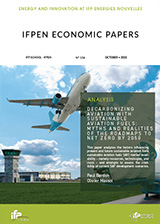 Decarbonizing aviation with sustainable aviation fuels: myths and realities of the roadmaps to net zero by 2050
Decarbonizing aviation with sustainable aviation fuels: myths and realities of the roadmaps to net zero by 2050
N° 156 – Octobre 2023 [ RECHERCHE ]
Paul Bardon, Olivier Massol
This paper analyzes the factors influencing present and future sustainable aviation fuels sustainable aviation fuels SAF) market availability – namely resources, technologies, and costs – and attempts to assess the credibility of current SAF development scenarios.![]() Lire la suite / Télécharger le numéro (PDF - 3.4 Mo)
Lire la suite / Télécharger le numéro (PDF - 3.4 Mo) ![]()
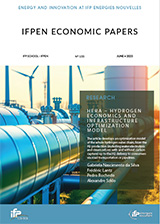 HERA – Hydrogen economics and infrastructure optimization model
HERA – Hydrogen economics and infrastructure optimization model
N° 155 – Juin 2023 [ RECHERCHE ]
Gabriela Nascimento da Silva, Frédéric Lantz, Pedro Rochedo, Alexandre Szklo
The article develops an optimization model of the whole hydrogen value chain, from the H2 production (including water electrolysis and steam reform with and without carbon capture) up to the H2 delivery to consumers via road transportation or pipelines.![]() Lire la suite / Télécharger le numéro (PDF - 2.1 Mo)
Lire la suite / Télécharger le numéro (PDF - 2.1 Mo) ![]()
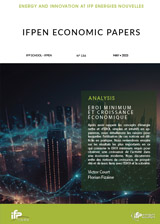 EROI minimum et croissance économique
EROI minimum et croissance économique
N° 154 – Mai 2023 [ RECHERCHE ]
Victor Court, Floriane Fizaine
Après avoir rappelé les concepts d’énergie nette et d’EROI, simples et intuitifs en apparence, nous détaillerons les raisons pour lesquelles l’utilisation de ces notions est difficile en pratique. Nous reviendrons ensuite sur les résultats les plus importants en ce qui concerne le EROI minimum requis pour observer une croissance de l’activité dans une économie moderne. Nous discuterons enfin des notions de croissance, de prospérité et de leurs liens avec l’EROI et la sobriété.![]() Lire la suite / Télécharger le numéro (PDF - 1 Mo)
Lire la suite / Télécharger le numéro (PDF - 1 Mo) ![]()
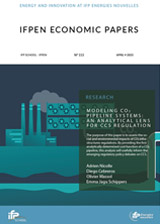 Modeling CO2 pipeline systems: An analytical lens for CCS regulation
Modeling CO2 pipeline systems: An analytical lens for CCS regulation
N° 153 – Avril 2023 [ RECHERCHE ]
Adrien Nicolle, Diego Cedreros, Olivier Massol, Emma Jagu Schippers
Carbon Capture and Storage (CCS) is regularly depicted as a crucial technology to reduce the social cost of achieving carbon neutrality. However, its deployment critically depends on the installation of CO2 infrastructures. As the regulatory procedures governing their provision are yet to be clarified, the purpose of this paper is to assess the social and environmental impacts of such regulations. We show how the engineering equations of a CO2 pipeline implicitly define a Cobb-Douglas production function. ![]() Lire la suite / Télécharger le numéro (PDF - 1.1 Mo)
Lire la suite / Télécharger le numéro (PDF - 1.1 Mo) ![]()
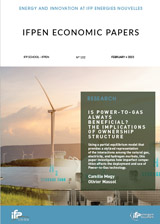 Is Power-to-Gas always beneficial? The implications of ownership structure
Is Power-to-Gas always beneficial? The implications of ownership structure
N° 152 – Février 2023 [ RECHERCHE ]
Camille Megy, Olivier Massol
Power-to-gas (PtG), a technology that converts electricity into hydrogen, is expected to become a core component of future low-carbon energy systems. While its economics and performance as a sector coupling technique have been well studied in the context of perfectly competitive energy markets, the distortions caused by the presence of large strategic players with a multi-market presence have received little attention. In this paper, we examine them by specifying a partial equilibrium model that provides a stylized representation of the interactions among the natural gas, electricity, and hydrogen markets.![]() Lire la suite / Télécharger le numéro (PDF - 2.5 Mo)
Lire la suite / Télécharger le numéro (PDF - 2.5 Mo) ![]()
> Archives des numéros (« Les Cahiers de l’Économie » - 2010 à 2022)
La forme et le fond peuvent encore être provisoires, notamment pour susciter des échanges de points de vue sur les sujets abordés. Les opinions exprimées dans cette collection appartiennent à leurs auteurs et ne reflètent pas nécessairement le point de vue d’IFP Energies nouvelles ou d’IFP School.
Ni ces institutions ni les auteurs n’acceptent une quelconque responsabilité pour les pertes ou dommages éventuellement subis suite à l’utilisation ou à la confiance accordée au contenu de ces publications.
Pour toute information sur le contenu, contacter directement l’auteur.






